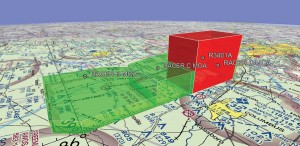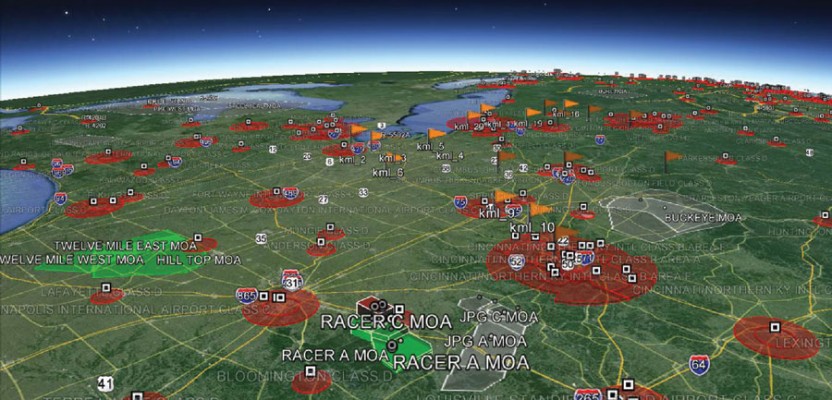Above picture: As COAs cross different airspace types, more coordination is required for the FAA to allows safe UAS operations in the National Airspace.
By now, most everyone reading this has at least some understanding of the potential benefits an unmanned aircraft system (UAS) has on their industry. I have read publications that mention that precision agriculture will be the biggest industry for UAS. However, whether the UAS is used by farmers or power-line inspectors, the data that is collected, stored, and manipulated has everything to do with location and geospatial professionals.
There are many companies developing systems that will capture and analyze data for a specific purpose, but the current public policy governing UAS flight operations makes it difficult to test these systems until improved integration policies are developed. Currently, the FAA has allowed only a limited number of civil UAS operations in the national airspace. This article provides a general description of the actual Certificate of Authorization (COA) process used by public entities and universities.
The Ohio/Indiana UAS Center and Test Complex provides assistance to several organizations wanting to conduct successful UAS operations. My position is to serve as a resource to other agencies as well as to interface with the Federal Aviation Administration (FAA) on matters pertaining to COAs. During my time at the UAS Center, I have worked on multiple UAS operations and reviewed several different types of UAS platforms: their capabilities and the sensors that are attached to them to achieve the desired business results.
Certificate of Authorization (COA)
A COA, issued by the FAA, is an authorization for public agencies and universities to operate an Unmanned Aircraft (UA) in the National Airspace (NAS). Once an application is submitted, the FAA conducts a comprehensive operational and technical review. The number one goal of the FAA is safety, and this is the primary tool the FAA uses to assess the impact of a UAS operation in the NAS. If approved, the COA will explicitly state the requirements and limitations for safe operations on the ground and in the air. Typically, this process takes about 60 (working) days to complete but may take longer depending on the operational complexities of the request as well as the current work load of the FAA reviewers.
Generally, there are three types of COA processes: for general flight operations, for emergency operations, and in the event of a national disaster. When emergency responders determine that a UAS is necessary to support their operations, an emergency or national disaster process can be used to greatly speed up the approval process. Both national disaster and emergency COAs are given top priority, and the FAA will expedite the requests to mitigate any safety concerns.
To help streamline the process, the FAA created an online system that enables the applicant to apply for a COA over the internet: ioeaaa.faa.gov/oeaaa/.
Prior to submitting a request for a COA, consider that:
Obtaining approval for access to the online COA application system takes time to process. Requests are made to the FAA headquarters in the UAS Group (AJV-13).

Different airspace types can intersect each other, which can complicate COA logistical planning. Shown are Military Operational Areas (MOA) and Restricted airspace. Each carry different requirements.
Prior to obtaining access to the online system, you will need to get a public declaration letter from your state attorney general’s office. This declaration letter states that you are in compliance with applicable state and federal laws to conduct public aircraft operations.
- Define your business and data requirements. Then determine what sensor will meet these requirements.
- Determine what airframe will best support the sensor and your business requirements.
- Start looking into the requirements of the proposed pilots and observers. Determine if you will be contracting piloting services or using in-house staff.
- Determine if you will be leasing or buying the aircraft.
- Review public and civil aircraft operation requirements.
- Begin looking into how you will assess and certify the airworthiness of the aircraft.
COA Application
The COA application itself, at least at the surface, seems straightforward, but as you begin the process you will find the complexities of some of the requirements to be challenging. Below is a summary the major sections of the application process.
Proponent information: This is the first major section that includes contact information and asks for your declarations, such as your public entity declaration. The FAA wants to make sure that you are familiar with the rules governing your proposed operation.
Operational description: The key parts of this section are the executive and operational summaries; they give the FAA a clear description of the type and purpose of the proposed operations. The executive summary is a description of why you want access to the NAS with your UA. The operational summary defines how you plan to perform your UAS operation. This section should give the FAA enough information to determine that the proposed operation is compliant with the applicable Code of Federal Regulations (CFR). In the operational summary section you define things like day/night operations, height above ground level, airspace, general locational information, etc.
UAS description/performance characteristics: This is where you describe the UAS you intend to operate. The description helps the FAA understand the capabilities and limitations of the system. Data used for flight characteristics are things like cruise speed, operating altitudes, and takeoff weight. Detailed launch and recovery procedures are also required.
Airworthiness: Airworthiness is the aircraft’s ability to sustain safe flight. This certification is typically maintained by performing a defined set of requirements to make sure the aircraft is fully mission-capable. Public agencies that have an established airworthiness policy can certify their aircraft’s airworthiness and submit the documentation in this section.
Procedures: This section
defines a set of documents that further define how you intend on mitigating any issues encountered during operations. The current documents required are:
- Lost link mission procedures: What happens if you lose RC control, GPS, computer link, etc.
- Lost communication procedures: What you have planned if you lose communication with the Air Traffic Control (ATC), your observers, etc.
- Emergency procedures: What actions you’ll take when an incident or accident occurs. Notify ATC? Contact authorities? Do you have a first aid kit and fire extinguisher available?
Special equipment: Below are several areas from this section of the COA application:
- Avionics equipment: transponder capabilities
- Lights: for navigational aids
- Spectrum analysis: frequencies being used and the Federal Communication Commission (FCC) licenses, if needed
- ATC communications equipment
- Visual and electronic detection capabilities
- Aircraft performance recording
Flight operations area: The operational area defines the boundaries of the proposed flights; a COA can have multiple flight operational areas. Each area can be defined with coordinates and a maximum mean sea level (MSL).
Flight crew qualifications: You describe the qualifications of the flight (PIC or Observer) crew. For the most part, the requirements for piloting a UAS in the NAS will be ground school or a private pilot’s license.
Some items to plan for prior to submitting your application:
- Assessment of your operations will guide how the COAs will be defined depending on geographic, topographic, and demographic data, i.e. proximity to airports, population, elevation change, line of sight, infrastructure etc.
- Operations will affect piloting requirements. If you are within 5NM of an airport, above 400’ or in any airspace classification other than G, the FAA will ask for more certifications, such as a
private pilot’s license. - Plan for consistent FAA coordination during application process.
FAA Internal Process
After the COA application is submitted, the FAA has a five-step review process:
- Admin Review
- ATC Feasibility Check
- Safety Review
- ATC Facility Coordination
- Signature
Steps two through four are the most critical and consume most of the time. During this process you will have a continuous dialog with the FAA, further clarifying and refining your proposed operation. My best advice for anyone applying for a COA is to treat the FAA with professionalism and realize they may be approaching issues from a different perspective and are there to help.
COA Waiver
Assuming everything went well and the FAA approved your request, you will receive your COA (FAA Form 7711-1) in a PDF. This document contains the requirements you need to perform your operations. The typical major sections are:
- Signature Page
- General Description Page
- Standard provisions section containing information such as:
- Airworthiness certification requirements
- Operational requirements and limitations with applicable CFRs and any visual flight rules that apply
- ATC communication requirements
- Safety of flight requirements
- Crew certification requirements
- Notice to Airmen (NOTAM) requirements
- Data reporting
- Incident reporting requirements
- Flight Standards Special Provisions: typically, requirements on contingency planning and flight limitations
- Air Traffic Control Special Provisions: ATC coordination and communication requirements
Operational Area Definition Items to consider after you have been issued a COA:
Coordination with ATC will be required. Documentation of that coordination would also be recommended.
- Monthly reporting will be required even if there are no flights.
- Are you ready for an incident or accident? Do you know how to file an incident report?
- Make sure to keep all of your certifications and waivers of all flights to be able to comply if an FAA inspector makes an inquiry.
During the last four years of submitting COAs, I have worked with several individuals in the FAA, and every time I have been impressed with their professionalism and support. As the FAA continues to integrate UAS into the NAS, their policies and regulations will change to adapt to this new transformational technology.
The information will most likely be outdated in the near future; however, the FAA’s mission to provide the safest, most efficient aviation system in the world will not. The potential business applications of UAS will be profound to the geospatial professional and will continue to make spatial special.
References:
- AC 00-1.1A – Public Aircraft Operations
- Unmanned Aircraft Systems (UAS) Operational Approval N8900.227
- Unmanned Aircraft Operations in the National Airspace System (NAS) NJO7210.873
- FAA Federal Aviation Regulations
- FAA UAS Integration Roadmap
- FAA Advisory Circular 91-57
- FAA Unmanned Aircraft Systems Q&A
- FAA Busting Myths about the FAA and Unmanned Aircraft

